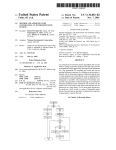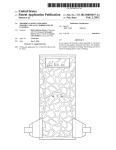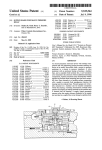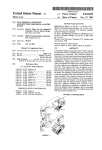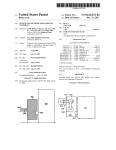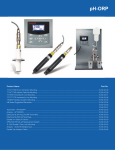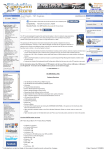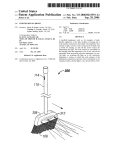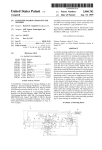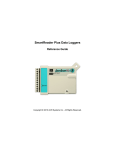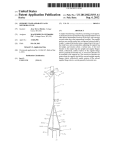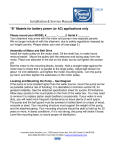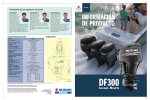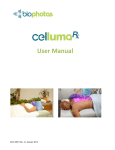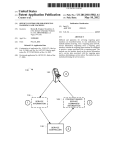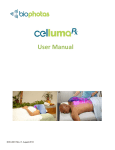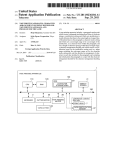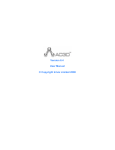Download Cleaning tool
Transcript
USOO8876421B2 (12) United States Patent (10) Patent N0.: Suda (54) US 8,876,421 B2 (45) Date of Patent: CLEANING TOOL (58) Nov. 4, 2014 Field of Classi?cation Search USPC ............ .. 401/139, 140, 251; 24/593.1, 598.5, (75) Inventor: Tomokazu Suda, Kagawa-ken (JP) 24/594.1; 403/375 See application ?le for complete search history. (73) Assignee: Uni-Charm Corporation, Ehime (JP) (56) (*) Notice: References Cited Subject to any disclaimer, the term of this patent is extended or adjusted under 35 US: PATENT DOCUMENTS U-S-C- 154(b)bY1096days- (21) Appl.No.: 12/096,477 (22) PCT Filed: Dec. 7, 2006 (86) PCT/JP2006/324488 PCT No.: 2,990,979 A * 7/1961 Harrison et a1. ............ .. 222/482 4,013,369 A * 3/1977 Turek .......................... .. 401/139 4,954,001 A 9/1990 Billat 6,698,700 B2* 3/2004 FOREIGN PATENT DOCUMENTS §371 (Cm), EP (2), (4) Datei Sell-16,2009 JP 1602 311 A2 2004242799 (87) PCT Pub. No.: W02007/066739 _ (30) _ English translation of First Of?ce Action from corresponding Chi nese application N0. 2006800459482 dated Jan. 8, 2010, 19 pages. Feb. 4, 2010 (Continued) Foreign Application Priority Data Dec. 9, 2005 9/2004 (Continued) Pm" Pubhcat‘o“ Data US 2010/0028072 A1 (51) _ 12/2005 OTHER PUBLICATIONS PCT Pub. Date: Jun. 14, 2007 (65) Moerke etal. ......... .. 248/22031 (Continued) Primary Examiner i David Walczak (JP) ............................... .. 2005-356867 14mm"! Examine/i Bradley Oliver (74) Attorney, Agent, or Firm * Brinks Gilson & Lione Int. Cl. A46B 11/00 (2006.01) (57) A47L 13/26 A4 7L 13/46 (2006-01) (2006-01) With respect to a cleaning tool having a sheetlike cleaning member for mopping a surface to be cleaned, it is intended to A4 7L 13/20 A4 7L 13/22 (2006-01) (2006-01) A4 7L 13/42 (2006-01) provide a technology effective for enhancing of cleaning effect. There is provided cleaning tool (10) comprising clean ing sheet (100) for mopping a surface to be cleaned and injection nozzle (252) for jetting a cleaning liquid toward the (52) U-s- Cl- ABSTRACT ............... .. surface to be cleaned at its region under the cleaning Sheet (2013.01); A47L 13/20 (2013.01); A47L 13/22 (2013.01); A47L 13/42 (2013.01) (100)' USPC ......................................... .. 401/140; 401/139 18 Claims, 12 Drawing Sheets 100 110 ( - 4 If; \ ’ \ 252 25] : ‘30 DepressZ32 %_1%_1 ‘20 250 230 210 US 8,876,421 B2 Page 2 (56) References Cited U_S_ PATENT DOCUMENTS 6,742,951 B2 * 6/2004 Schultz et a1. .............. .. 401/139 2004/0018038 A1 1/2004 Schultz et a1. 2006/0171767 A1* 8/2006 Hoadley et a1. ............. .. 401/136 2006/0171768 A1 8/2006 Hoadley et al. FOREIGN PATENT DOCUMENTS JP 2004305473 A 11/2004 JP 2005-533567 A 11/2005 JP 2005533567 11/2005 W0 WO 2004/008931 A1 1/2004 W0 WO 2006/113386 A2 10/2006 OTHER PUBLICATIONS English translation of Of?ce Action from corresponding Japanese application No. 2005-356867 dated Aug. 23, 2010, 21 pages. European Search Report from corresponding European application N0. 068342435 dated Jan. 14, 2014 (3 pgs). JP 2004242799 A JP 2004305473 9/2004 11/2004 * cited by examiner US. Patent NOV. 4, 2014 Sheet 1 0f 12 US 8,876,421 B2 US. Patent NOV. 4, 2014 Sheet 2 0f 12 US 8,876,421 B2 US. Patent NOV. 4, 2014 08 \ / .25 \ SNNON 2a23\ 2Nm2 2% w SN2%SN88 Sheet 3 0f 12 El NvDENNN 3J13 2w:EN5 k m EN.5 F\ / \ _ _ w i J>> \ 5 NaSN .UEm US 8,876,421 B2 2N8N8N US. Patent NOV. 4, 2014 Sheet 4 0f 12 US 8,876,421 B2 US. Patent Nov. 4, 2014 Sheet 5 0f 12 120 FIG.5 US 8,876,421 B2 US. Patent .UEN. NOV. 4, 2014 Sheet 7 0f 12 US 8,876,421 B2 US. Patent NOV. 4, 2014 US 8,876,421 B2 Sheet 8 0f 12 28. 2 2: mmo: / o: 0...Ll NmN/ d __ 2: .UEw Os5 \Nh% US. Patent NOV. 4, 2014 Sheet 9 0f 12 US 8,876,421 B2 meow mwow NY Moo— wa NowFow\ wa mw..3.UEm / Vv./ Hw..-UM.E-. OPP / US. Patent NOV. 4, 2014 .UE2 Sheet 10 0f 12 US 8,876,421 B2 US. Patent NOV. 4, 2014 :.UE Sheet 11 0f 12 US 8,876,421 B2 US. Patent NOV. 4, 2014 2.05 Sheet 12 0f 12 US 8,876,421 B2 US 8,876,421 B2 1 2 CLEANING TOOL uneven or stepped. The cleaning element may be of dispos able type designed for single use, or reusable type which can CROSS-REFERENCE TO PRIOR APPLICATION be reused by washing. The cleaning element is typically formed of plastic nonwoven fabric or a laminate thereof, or resin foam. The faces to be cleaned may be either ?at or curved, uneven or stepped. This is a US. National Phase Application under 35 U.S.C. §37l of International Patent Application No. PCT/JP2006/ 324488 ?led Dec. 7, 2006, and claims the bene?t of Japanese PatentApplication No. 2005-356867, ?led Dec. 9, 2005, both of them are incorporated by reference herein. The Interna tional Application was published in Japanese on Jun. 14, 2007 The holding part in this invention is con?gured to be attached to the cleaning element and designed to detachably hold the cleaning sheet. Thus, the cleaning element can be removed from the holding part and replaced with new one as necessary depending on the degree of dirt of the cleaning as WO 2007/066739 Al under PCT Article 21(2). element. The grip in this invention is con?gured as an elongate part FIELD OF THE INVENTION to be held by a user. The user can hold the grip and perform a wiping operation by the cleaning element. Further, prefer The present invention relates to a cleaning tool, and more particularly to a cleaning tool having a sheet-type cleaning element for wiping a region to be cleaned inside a room or a vehicle and so on. BACKGROUND OF THE INVENTION 20 Various types of cleaning tools having a sheet-type clean ing element for wiping a region to be cleaned are known. For example, Japanese non-examined laid-open Patent Publica tion No. 2004-242799 discloses a cleaning tool in which an 25 agent permeating bottom part is provided on the bottom of a cleaning frame and the cleaning sheet is wrapped around the agent permeating bottom part. In this known cleaning tool, in use for wiping, the cleaning sheet is dampened with a clean ing agent which is sprayed from above the agent permeating bottom part during cleaning operation. Such a cleaning tool is 30 ably, the cleaning element may have a rectangular shape, and the long side of the rectangular cleaning element is designed to extend along the length direction of the elongate grip. With this construction, the ef?ciency of user’s wiping operation can be easily improved. The connecting part in this invention is disposed between the holding part and the grip and designed to ?xedly connect the holding part and the grip. Speci?cally, the holding part and the connecting part are ?xedly connected together, and the grip and the connecting part are ?xedly connected together. Thus, as a whole, the holding part, the connecting part and the grip are integrally ?xed to each other. In this case, two or all of the holding part, the connecting part and the grip may be integrally molded, or all of them may be separately molded and thereafter ?xedly connected together. The struc capable of wiping off tough dirt on a ?oor surface which is ture of “?xedly” connecting the holding part and the grip in this invention only requires that the holding part and the grip dif?cult to remove with a dry cleaning sheet. However, in are integrally ?xed or retained at least during use of the designing a cleaning tool of this type having a sheet-type cleaning element, a technique for further enhancing the clean ing effect is desired. cleaning tool. Therefore, it includes not only a structure in 35 which relative movement at the connection between the hold ing part and the connecting part or at the connection between the grip and the connecting part is disabled, but also widely includes a movable structure in which relative movement at DISCLOSURE OF THE INVENTION Problems to be Solved by the Invention 40 It is, accordingly, an object of the present invention to provide an effective technique for enhancing the cleaning effect in a cleaning tool having a sheet-type cleaning element for wiping a face to be cleaned. 45 Means for Solving the Problems these connections is temporarily enabled. With regard to this movable structure, speci?cally, a hinge mechanism and a locking mechanism can be provided at the connection between the holding part and the connecting part or at the connection between the grip and the connecting part. The angle between the holding part and the connecting part or the angle between the grip and the connecting part can be adjusted via the hinge mechanism before and after use of the cleaning tool, and it can be locked or retained at a predeter mined angle by the locking mechanism during use of the cleaning tool. The above-described problem canbe solved by the features of the claimed invention. This invention can be applied to the 50 The cleaning liquid supply part in this invention has a supply noZZle for supplying cleaning liquid toward the face to construction of cleaning tools having a sheet-type cleaning element for wiping faces to be cleaned (?oors, walls, ceilings, be cleaned, and is disposed on at least one of the holding part, external walls, furniture, clothes, curtains, bedding, home the grip and the connecting part. The “cleaning liquid” here electric appliances, etc.) inside and outside of houses, apart ments, buildings, factories, vehicles, etc. or faces of human body parts to be cleaned. The above-described problem canbe solved with the clean ing tool according to this invention. The cleaning tool 55 polishing wax-containing cleaner, a fragrance-containing cleaning liquid, a deodorant-containing cleaning liquid, or dilution of any of those liquids with water, or water itself can be used as the cleaning liquid. Further, as the manner of includes at least a cleaning element, a holding part, a grip, a connecting part and a cleaning liquid supply part. widely includes liquids which can be used for cleaning opera tion of removing dirt. Typically, a cleaner for cleaning ?oor, a 60 “supplying cleaning liquid”, a supply manner of injecting or The cleaning element of this invention is designed as a jetting cleaning liquid or spraying it in an atomized state, or a sheet-type cleaning element for wiping a face to be cleaned. supply manner of dropping cleaning liquid can be used, pro vided that the cleaning liquid is supplied not via the cleaning The “sheet-type cleaning element” here widely includes those having a plate-like form in the state in which it is attached to or detached from the holding part, which plate like form is considerably longer and wider than is thick. The surface of the cleaning element may be either ?at or curved, element but directly onto the face to be cleaned. Further, in 65 this invention, the cleaning liquid supply part may be mounted on any one of the holding part, the grip and the connecting part, or it may be mounted to extend on more than US 8,876,421 B2 4 3 one of the holding part, the grip and the connecting part. Once the face to be cleaned onto which the cleaning liquid has been Preferably, further in terms of the direction of installation height, the supply nozzle of this cleaning tool may be located supplied is wiped with the cleaning element, the cleaning above a sheet lower surface of the cleaning element and in a element can be used as a wet-type cleaning element with a height region in which an extension line of the holding part intersects with an extension line of the connecting part. In damp sheet surface. In a cleaning operationusing the cleaning element without supplying the cleaning liquid on the face to other words, preferably, the supply nozzle may be located below the grip and rearward of the connecting part, and above be cleaned, naturally, the cleaning element can also be used as a dry-type cleaning element with a normally dry sheet sur face. Further, as for the speci?c construction of the cleaning liquid supply part, for example, the construction which uses a a sheet lower surface of the cleaning element and in a height region in which an extension line of the holding part intersects with an extension line of the connecting part. With this construction, when the cleaning element is in contact with the face to be cleaned, the supply nozzle can be prevented from interfering with the face to be cleaned. Fur pump mechanism to pressurize cleaning liquid and discharge the pressurized cleaning liquid to the supply nozzle, the con struction of aerosol type which supplies pressurized cleaning ther, the supply nozzle can be located as close as possible to the face to be cleaned, so that the cleaning liquid can be reliably and promptly supplied onto a desired region on the face to be cleaned. liquid to the supply nozzle by using gas pressure, the con struction which causes cleaning liquid to drop from the sup ply nozzle under its own weight, and the construction which supplies cleaning liquid to the supply nozzle after the clean ing liquid is pressurized in a cleaning liquid supply source outside the cleaning liquid supply part, can be appropriately used. Further, the cleaning liquid supply part may be con?g Preferably, the cleaning liquid supply part of this cleaning tool may be con?gured to supply the cleaning liquid from the 20 ured to include a region which stores cleaning liquid and a path through which the cleaning liquid ?ows, or to include only a region through which cleaning liquid ?ows after the ing element can be moved downward and used for a wiping 25 cleaning liquid is supplied from the cleaning liquid supply source located outside the cleaning liquid supply part. Further, in this invention, an extension line in a length direction of the grip intersects with a normal to a sheet plane of the cleaning element at a predetermined angle. With this construction and with the construction in which the holding 30 part, the connecting part and the grip are integrally ?xed to each other, the cleaning tool of this invention is designed speci?cally as a hand-held cleaning tool of which length from the grip to the holding part via the connecting part is limited curve of the connecting part at a predetermined point can be de?ned as the extending direction of the connecting part. With the construction in which the orientation of the supply nozzle conforms to the extending direction of the connecting part, the operation of supplying a cleaning liquid to the face to be cleaned and the operation of wiping with the cleaning sheet 40 can be facilitated. the cleaning tool with one hand for cleaning operation. With this construction, dirt and dust which are stuck to the face and dif?cult to wipe off with a dry-type cleaning element area with the cleaning element. Particularly, in this invention, the cleaning liquid is supplied directly onto the face to be cleaned, so that the cleaning effect of the cleaning liquid itself In the cleaning tool, preferably, the cleaning liquid supply part may include a pump mechanism that pressurizes clean ing liquid by user’ s manual operation of an operation part and then discharges the pressurized cleaning liquid to the supply 45 nozzle. As the pump mechanism, a mechanical pump mecha 50 user’s manual operation of the operation part, or an electric pump mechanism which is actuated by a driving force of an electric motor, which electric motor is driven in conjunction with the user’s manual operation of the operation part, can be nism which is actuated by using a pressing force applied in the can be maximized. Therefore, compared with a cleaning tool in which cleaning liquid is supplied not onto the face to be cleaned but to the cleaning element, this construction is advantageous and effective in improving the cleaning effect. In the above-described cleaning tool, preferably, the supply nozzle of the cleaning liquid supply part may be located below the grip and rearward of the connecting part. With this construction, supply of the cleaning liquid from appropriately used. Further, the manual operation of the operation part includes the operation of pressing or depress ing the operation part in the form of a push button, and the operation of sliding the operation part in the form of a slide the supply nozzle to the face to be cleaned is not easily interfered with by the long grip and the connecting part. operation. Thus, a series of operations from a cleaning liquid supply operation to a subsequent wiping operation with the cleaning element can be more smoothly performed. In the cleaning tool, preferably, the orientation of the sup ply nozzle of the cleaning liquid supply part may conform to an extending direction of the connecting part. The extending direction of the connecting part represents the direction in which the connecting part extends from the grip to the holding part, and if the connecting part is curved, a tangent to the 35 within a predetermined range so that a user can hold and use can be easily wiped off by supplying cleaning liquid from the supply nozzle of the cleaning liquid supply part onto the face to be cleaned and then wiping this cleaning liquid supplied supply nozzle obliquely downward and forward toward a region located below the cleaning element. With this construction, subsequently to supply of the clean ing liquid from the supply nozzle, in the as-is state, the clean 55 switch. Further, the user can readily check the cleaning liquid sup plied area from behind, so that the operation of supplying the a means for supplying cleaning liquid to the supply nozzle. cleaning liquid can be smoothly and reliably performed. In the above-described cleaning tool, preferably, a region disposed on the underside of the grip, and the pump mecha of connection between the holding part and the connecting With the construction, the pump mechanism can be used as In the cleaning tool, preferably, the operation part may be 60 part may generally coincide with a rear end of the cleaning element. In other words, the supply nozzle may be located rearward of the connecting part and preferably rearward of nism is actuated by user’s operation of depressing the opera tion part with a ?nger while holding the grip with the hand. By using the depressing operation with the user’s ?nger to actu the supply nozzle to the face to be cleaned is not easily ate the pump mechanism, the application of force to the operation part can be easily achieved. Further, the action of holding the grip is an extension of the depressing operation with the ?nger. Therefore, the user can hold the grip and interfered with by the cleaning element. smoothly perform the depressing operation with the ?nger. the rear end of the cleaning element. With this construction, supply of the cleaning liquid from 65 US 8,876,421 B2 5 6 Further, this construction is preferably con?gured such that the operation part is located in the position of the ball of the user’s fore?nger when the grip is held by the user. on the degree of dirt of the face to be cleaned. Thus, the With this construction, actuation of the pump mechanism can be effected by the user’s operation of depressing the preferably include a housing that forms an outer shell of the cleaning tool having higher usability can be provided. The cleaning liquid supply part in the cleaning tool may cleaning liquid supply part, and a storage tank that stores cleaning liquid, and the housing and the storage tank are integrally con?gured as an assembly. The storage tank may be designed as a tank of the type which is ?xedly provided for exclusive use within the housing and re?lled with cleaning operation part with the ?nger. Preferably, the operation part in the cleaning tool may be con?gured as an operation button to be touched by the user’ s ?nger, and a ?nger entry preventing region for preventing entry of the user’s ?nger is provided between the operation button and the grip. The “?nger entry preventing region” here liquid as needed. Alternatively, it may be designed as a car tridge-type tank which can be replaced with new one when it runs out of cleaning liquid. As for the speci?c construction of is de?ned as a region which is con?gured such that an unnec essary hollow or space into which the user’s hand or ?nger may be caught in or enter and thus interfere with user’s this cartridge-type tank, for example, it may typically include a storage container molded of hard resin, and also include a pouch-type bottle formed of pouch sheet material and a stor age container formed of transparent or semitransparent resin operation is not created between the operation button and the grip. This provision of the ?nger entry preventing region is typically realized by the construction con?gured such that a base of the operation button which is located on the grip side is as large as or slightly larger than a top of the operation button and such that the outer edge portion of the base of the operation button extends substantially straight toward the outer edge portion of the top of the operation button. Particu larly, in the case of a hand-held cleaning tool, the position of the hand or ?nger of the user holding the grip and the grip 20 con?gured. The cleaning liquid supply part in the cleaning tool may 25 force applied to the hand or ?nger vary depending on the kind of the face to be cleaned or other similar factors. Therefore, with a construction having an unnecessary space between the operation button and the grip, the user’ s hand or ?nger may be caught on the operation button or enter the space, which may interfere with the user’s operation. It is therefore preferred to 30 tion button and the grip. This construction can prevent occurrence of such a trouble 35 mum so that the amount of supply of the cleaning liquid to the face to be cleaned can be adjusted in ?ne increments. With storage tank can be enhanced. With such a con?guration in which the sectional shape of the housing substantially conforms to the sectional shape of the storage tank, the unity between the housing and the stor age tank can be enhanced. In the cleaning liquid supply part of the cleaning tool, With this construction, the user can supply a predetermined amount of cleaning liquid from the supply nozzle to the face to be cleaned in one manual operation of the operation part. Preferably, the amount of discharge of the cleaning liquid in one manual operation of the operation part is set to the mini preferably be con?gured such that an outer peripheral surface of the housing is contiguous to an outer peripheral surface of the storage tank. With such a con?guration that is contiguous from the outer peripheral surface of the housing to the outer peripheral sur face of the storage tank, the unity between the housing and the The cleaning liquid supply part in the cleaning tool may preferably be con?gured such that the sectional shape of the housing substantially conforms to the sectional shape of the storage tank. provide the ?nger entry preventing region between the opera that may interfere with the operation. Preferably, the pump mechanism in the cleaning tool may discharge a predetermined amount of cleaning liquid to the supply nozzle in one manual operation of the operation part. material through which the remaining amount of cleaning liquid can be visually checked. With this construction, the cleaning tool can be provided in which the housing that forms the outer shell of the cleaning liquid supply part and the storage tank that stores the cleaning liquid are integrally 40 preferably, an outer surface of the tank housing may be simi lar in color to an outer surface of the storage tank. The “simi lar color” in this invention includes not only the same color but colors of the same kind. For example, a combination of 45 white and milky white, a combination of a transparent color warm colors, a combination of cold colors, a combination of this construction, excessive supply of the cleaning liquid to and a semitransparent color can be de?ned as a combination the face to be cleaned can be prevented by repeating the manual operation until a desired amount of cleaning liquid is supplied to the face to be cleaned. of similar colors. With such a construction in which the outer surface of the tank housing is similar in color to the outer surface of the Preferably, the cleaning liquid supply part in the cleaning 50 storage tank, the unity between the housing and the storage tool may further include an adjusting mechanism. Particu tank can be enhanced. larly preferably, the adjusting mechanism may have a func tion of adjusting the conditions for supplying the cleaning preferably include an elongate housing that forms an outer The cleaning liquid supply part of the cleaning tool may shell of the cleaning liquid supply part. Particularly prefer liquid from the supply nozzle to the face to be cleaned. The “conditions for supplying the cleaning liquid” include the 55 the grip and serve as a supplementary grip that is supplemen amount, the range (angle), the distance and the area of supply of the cleaning liquid. For example, in a construction in which tary to the grip. With this construction, the grip and the supplementary grip the cleaning liquid is injected (jetted) from the supply nozzle, it represents the amount, the range (angle), the distance and the area of injection (jet) of the cleaning liquid. As for the speci?c construction of the adjusting mechanism, it may be 60 attached to the grip can provide a wider region which can be held by the user. Preferably, the elongate housing of the cleaning tool may be removable from the grip. Further, preferably, in user’s cleaning operation, the cleaning tool offers ?rst use mode and constructed such that the sectional area of the throttle hole within the supply nozzle can be adjusted by using a switch or other similar switching device, so that the conditions for supplying the cleaning liquid can be adjusted. With provision of the adjusting mechanism, the conditions for supplying the cleaning liquid can be adjusted depending ably, the elongate housing may be con?gured to be attached to second use mode. The ?rst use mode is de?ned as a use mode 65 in which the user holds and uses the supplementary grip of the elongate housing attached to the grip. In this ?rst use mode, the cleaning tool has a function of supplying cleaning liquid. US 8,876,421 B2 7 8 Once the face to be cleaned onto which the cleaning liquidhas in order to be locked to the elongate hole. Therefore, the been supplied is wiped with the cleaning element, the clean elongate housing can be positioned with respect to the grip in ing element can be used as a wet-type cleaning element with a damp sheet surface. On the other hand, the second use mode a simple and reliable manner. is de?ned as a use mode in which the user holds and uses the be locked on an edge of one end of the one locking part in the grip to which the elongate housing is not attached. In this form of the elongate hole, and the second locking hook is second use mode, the cleaning tool does not have a function of locked on an edge of the other end of the elongate hole. In the cleaning tool, preferably, the ?rst locking hook may supplying cleaning liquid, the cleaning element is used as a dry-type cleaning element with a dry sheet surface. Speci?cally, the other locking part that locks the second lock ing hook is preferably con?gured by using the edge of the With this construction, the user can use the two separate use modes depending on the kind of dirt on the face to be single elongate hole which also serves as the one locking part. With this construction, the edge of the single elongate hole cleaned or other similar conditions. Thus, the cleaning tool can be rationally used as the two locking parts. having higher usability can be provided. Further, if the clean In the cleaning tool, the connecting part may be curved, and ing tool for use in the second use mode, with the elongate the elongate housing may be curved to conform to the curve of the connecting part and such that an end of the elongate housing on the side of the supply nozzle is located at a lowest housing removed from the grip, is designed and manufac tured as a ?nal product, advantageously, the cleaning tool can be converted into a product with the cleaning liquid supply mechanism for use in the ?rst use mode. Preferably, the grip of the cleaning tool may have two locking parts formed along the length direction of the grip, while the elongate housing has two locking hooks that are disposed in the length direction of the housing and can be locked to the associated locking parts. In this case, preferably, the two locking hooks can be locked to the associated locking parts so that the elongate housing is attached to the grip. The manner of “locking” the locking hooks to the associated locking parts here widely includes the manner of ?xedly connecting each other, for example, by hooking one on the 20 that a concave space is created underneath the connecting part. This construction rationally allows easy placement of the supply nozzle when the cleaning liquid supply part is 25 disposed under the connecting part. Further, by forming the elongate housing having a curved shape that conforms to the curve of the connecting part, unnecessary space can be prevented from being created in the outer shape of the cleaning tool. Thus, the overall size of the cleaning tool can be effectively reduced. other or ?tting one in or on the other. Therefore, speci?cally, each of the locking parts to which the locking hooks are level. Particularly, preferably, the connecting part may be convexly curved upward above the cleaning element. In other words, the connecting part may preferably be curved such 30 In the cleaning tool, preferably, the holding part, the grip locked comprises a hole, a groove or a slit. Further, the two and the connecting part may be resin molded. With this con locking parts may be independently con?gured as separate struction, the entire cleaning tool can be reduced in weight. holes, or the edge of a single hole may serve as the two locking In the cleaning tool, preferably, the holding part, the grip parts. Further, as long as the cleaning tool is con?gured to have at least the two locking parts and at least the two locking hooks, another locking part or locking hook may be addition ally provided. and the connecting part are integrally molded. With this con struction, the costs of manufacturing the cleaning tool can be reduced. According to this invention, in a cleaning tool having a With provision of the two locking parts formed along the length direction of the grip, the state of attachment of the elongate housing to the grip can be stabilized. The cleaning tool may preferably include a ?rst locking sheet-type cleaning element for wiping a face to be cleaned, the cleaning effect can be enhanced particularly by attach ment of a cleaning liquid supply part having a supply nozzle that can supply cleaning liquid directly onto a face to be 35 40 hook which is locked to one of the two locking parts and a second locking hook which is locked to the other locking part. Further, preferably, the ?rst locking hook may be locked to the one locking part with the second locking hook held dis cleaned. BRIEF DESCRIPTION OF THE DRAWINGS 45 engaged from the other locking part, and subsequently, while FIG. 1 is a side view of a cleaning tool 10 according to this embodiment of the invention. FIG. 2 is a plan view of the cleaning tool 10 in FIG. 1. keeping the locked state, the elongate housing is rotated in a direction in which the second locking hook moves toward the other locking part. By this rotation, the second locking hook other locking part. Therefore, the elongate housing can be FIG. 3 schematically shows the internal structure of a sec ond structure 200 in this embodiment. FIG. 4 is a perspective view showing the construction of a ?rst structure 100 in this embodiment. FIG. 5 is a perspective view showing a cleaning sheet holder 120 in FIG. 4 which is shown separated into a holder body 130 and a handle 140. FIG. 6 is a side view of the cleaning tool 10 in this embodi attached to the grip in a simple and reliable manner. ment, showing together the internal structure of the second In the cleaning tool, preferably, the one locking part may comprise an elongate hole extending along the length direc structure 200 when an operation button 232 is pressed. FIG. 7 is a plan view ofthe cleaning tool 10 in this embodi is locked to the other locking part. In order to attach the elongate housing to the grip, the ?rst locking hook is locked to the one locking part so that the 50 elongate housing is positioned with respect to the grip, and then while keeping this locked state, the elongate housing is rotated, so that the second locking hook can be locked to the tion of the grip, and the ?rst locking hook has a front end 55 60 projecting along the longitudinal direction of the elongate hole. Further, preferably, the ?rst locking hook may be moved with respect to the elongate hole in the longitudinal direction of the elongate hole, and by this relative movement, the ?rst locking hook is locked to the elongate hole. The ?rst locking hook can be moved in the longitudinal direction of the elongate hole with respect to the elongate hole ment, showing together the internal structure of the second structure 200 when the operation button 232 is pressed. FIG. 8 is a side view of the cleaning tool 10 in this embodi ment, showing together the internal structure of the second structure 200 immediately after release of the operation but 65 ton 232. FIG. 9 shows the state in which the second structure 200 is removed from the ?rst structure 100, as viewed from the side. US 8,876,421 B2 10 FIG. 10 shows the process of attaching the second structure 200 to the ?rst structure 100, as viewed from the side. FIG. 11 shows the process of attaching the second structure 200 to the ?rst structure 100, as viewed from the side. FIG. 12 shows the process of attaching the second structure 200 to the ?rst structure 100, as viewed from the side. nozzle 252 conforms to the extension line L4 of the connect ing part 14111 (the extending direction of the connecting part according to this invention). In this invention, the number, installation position and orientation of the injection nozzle 252 can be appropriately changed as necessary. For example, the supply nozzle in the form of the injection nozzle 252 may be located forward of the connecting part 14111, or it may be BEST MODES FOR PERFORMING THE INVENTION disposed on the front or rear end of the holder body 130. Further, a ?rst locking hook 201 and a second locking hook 202 are formed on the top of the housing of the second structure 200 and arranged on a straight line in the longitudi A representative embodiment of the present invention is nal direction. The ?rst locking hook 201 and the second locking hook 202 can engage with a longitudinally elongate now described with reference to the drawings. First, the struc ture of a cleaning tool 10 according to this embodiment is explained with reference to FIGS. 1 to 5. FIG. 1 is a side view of the cleaning tool 10 according to this embodiment, and FIG. 2 is a plan view of the cleaning tool 10 in FIG. 1. As shown in FIGS. 1 and 2, the cleaning tool hole (engagement hole) 142 formed through the cleaning sheet holder 120 of the ?rst structure 100. With this construc tion, the ?rst locking hook 201 and the second locking hook 202 are engaged and locked in the single elongate hole 142, so 10 consists of a ?rst structure 100 and a second structure 200. that the cleaning sheet holder 120 of the ?rst structure 100 is The ?rst structure 100 includes the cleaning sheet holder 120 and the cleaning sheet 110 attached to the cleaning sheet holder 120, which will be described below in more detail. A housing 20011 of the second structure 200 is generally cylindrical and includes, from rear to front, a tank housing 210, a pump housing 230 and a discharge housing 250. The housing 200a forms an outer shell of the second structure 200 retained on the second structure 200 side. 20 25 and is designed as an operation part (handle part) which is held by the user for cleaning operation using the cleaning tool as rubber and resin, and the ?rst locking hook 201 projects forward to a front end 201a, while the second locking hook 202 projects rearward to a rear end 202a. Further, the distance between the front of the base of the ?rst locking hook 201 and the rear of the base of the second locking hook 202 (distance d2 in FIG. 1) is substantially equal to or slightly longer than the length of the elongate hole 142 in the longitudinal direc tion (distance d1 in FIG. 2). Further, the distance between the 1 0. Although it will be described below in more detail, a pump mechanism is disposed in the pump housing 230, and when an operation button 232 disposed on the underside of the housing Speci?cally, the ?rst locking hook 201 and the second locking hook 201 are both formed of an elastic material such 30 front end 20111 of the ?rst locking hook 201 and the rear end is manually operated, the pump mechanism sucks in cleaning liquid which is stored in a storage tank within the tank hous 20211 of the second locking hook 202 (distance d3 in FIG. 1) is longer than the length of the elongate hole 142 in the ing 210, pressurizes it and then discharges the pressurized cleaning liquid. The cleaning liquid discharged from the longitudinal direction (distance d1 in FIG. 2). pump mechanism is injected from an injection nozzle 252 Therefore, in order to attach the cleaning sheet holder 120 35 through a discharge path formed in the discharge housing 250. The injection nozzle 252 here is a feature that corre sponds to the “supply nozzle” according to this invention. As the cleaning liquid to be injected from the injection nozzle 252, a cleaner for cleaning ?oor, a polishing wax-containing cleaner, a fragrance-containing cleaning liquid, a deodorant containing cleaning liquid, or dilution of any of those liquids 40 biasing forces of the ?rst locking hook 201 and the second locking hook 202 act upon the cleaning sheet holder 120 in its longitudinal direction and in the downward direction. By this elastically pressing action of the hooks, the cleaning sheet with water, or water itself can be used. In this embodiment, an extension line L1 in the length direction of a handle body 141 intersects with a normal L2 to of the ?rst structure 100 to the second structure 200, the ?rst locking hook 201 is locked to a front end 14211 of the elongate hole 142 and the second locking hook 202 is locked to a rear end 1421) of the elongate hole 142. As a result, the elastic 45 holder 120 can be securely retained on the second structure 200 side. The ?rst locking hook 201 here is a feature that corre a sheet plane of the cleaning sheet 110 at a predetermined sponds to the “locking hook” and the “?rst locking hook”, and angle. In the representative example shown in FIG. 1, this angle is about 90°. Further, in this embodiment, a region of connection between a holder body 130 (of the cleaning sheet holder 120) and a connecting part 14111 (the handle body 141) the second locking hook 202 here is a feature that corresponds to the “locking hook” and the “second locking hook” accord ing to this invention. Further, the elongate hole 142 is a feature that corresponds to the “elongate hole”, the front end 14211 of the elongate hole 142 is a feature that corresponds to the “locking part” and the “one locking part”, and the rear end 1421) of the elongate hole 142 is a feature that corresponds to 50 generally coincides with the rear end (right end as viewed in FIG. 1) of the cleaning sheet 110. In addition, the holder body 130, the connecting part 141a and the handle body 141 are integrally ?xed to each other. Therefore, the cleaning tool 10 in this embodiment is designed speci?cally as a hand-held the “locking part” and “the other locking part” according to 55 cleaning tool of which length from the handle body 141 to the holderbody 130 via the connecting part 14111 is limited within The internal structure of the second structure 200 is now explained with reference to FIG. 3. FIG. 3 schematically a predetermined range so that a user can hold and use the cleaning tool with one hand for cleaning operation. Further, in this embodiment, the injection nozzle 252 is 60 located below the handle body 141 and rearward of the con necting part 141a. Further, in terms of the direction of instal lation height, the injection nozzle 252 is located above the lower surface of the cleaning sheet 110 and in a height region in which an extension line L3 of the holder body 130 inter sects with an extension line L4 of the connecting part 141a. Further, in this embodiment, the orientation of the injection this invention. 65 shows the internal structure of the second structure 200 in this embodiment. FIG. 3 shows the initial state in which the opera tion button 232 is not pressed. As shown in FIG. 3, the tank housing 210 contains a stor age tank 212 for storing cleaning liquid, a supply tube 214 for supplying the cleaning liquid from the storage tank 212 to the pump mechanism 240 disposed in the pump housing 230, a tank cap 216 that hermetically closes the storage tank 212 and has an air hole 217 on its rear end, and a valve mechanism 220 mounted to the tank cap 216. The storage tank 212 is a feature US 8,876,421 B2 11 12 that corresponds to the “storage tank” according to this inven tion. The storage tank 212 is integrally con?gured with the Further, as shown in FIG. 3, a guide tube 251 is disposed within the discharge housing 250, and through the guide tube 251, the cleaning liquid discharged from the outlet port 244 is housing 20011 that forms the outer shell of the second structure 200 or with the tank housing 210 as an assembly. guided to the injection nozzle 252 mounted on the housing front end. This guide tube 251 and the above-mentioned supply tube 214 are preferably formed by using ?exible mate Further, in this embodiment, preferably, the outer periph eral surface of the tank housing 210 is contiguous to the outer peripheral surface of the storage tank 212, and the tank hous ing 210 has a circular or elliptical section that substantially conforms to the sectional shape of the storage tank 212. Further, in this embodiment, preferably, the outer surface of rials, or typically, silicon resin, polyurethane resin (PU), polyethylene resin (PE), etc. The cleaning liquid led to the injection nozzle 252 through the guide tube 251 is injected onto a desired region to be cleaned, through a throttle hole 253 provided within the injection nozzle 252. The throttle hole 253 of the injection nozzle 252 is directed obliquely forward. As described above, the storage tank 212, the pump mecha nism 240, the injection nozzle 252 and other component parts the tank housing 210 is similar in color to the outer surface of the storage tank 212. The “similar color” here includes not only the same color but colors of the same kind. For example, a combination of warm colors, a combination of cold colors, a combination of white and milky white, a combination of a transparent color and a semitransparent color can be de?ned as a combination of similar colors here. With such a prefer which are housed or mounted in the tank housing 210, the pump housing 230 or the discharge housing 250 form the “cleaning liquid supply part” according to this invention. able construction, the unity between the tank housing 210 and Now, the construction of the ?rst structure 100 is explained the storage tank 212 can be enhanced. The tank cap 216 is threadably mounted on the housing body of the tank housing 210. The tank cap 216 can be in detail with reference to FIGS. 4 and 5. FIG. 4 is a perspec 20 mounted on the housing body by screwing the tank cap 216, while the tank cap 216 can be removed from the housing body separated into a holder body 130 and a handle 140. As shown in FIG. 4, the ?rst structure 100 includes the by unscrewing the tank cap 216. Further, preferably, an O-ring (not shown) for preventing leakage of cleaning liquid 25 may be mounted on the threaded portion of the tank cap 216 and connecting portions in the areas of the pump mechanism cleaning sheet 110 and the cleaning sheet holder 120. The cleaning sheet 110 includes a cleaning sheet body 111 and a joining sheet 112 overlaid on and joined to the upper 240, the injection nozzle 252, etc. through which cleaning liquid runs. The material of the O-ring can be appropriately selected based on its resistance to cleaning liquid to be used, tive view showing the construction of the ?rst structure 100 in this embodiment, and FIG. 5 is a perspective view showing the cleaning sheet holder 120 in FIG. 4 which is shown 30 face of the cleaning sheet body 111. The cleaning sheet 110 is preferably designed as a sheet-type cleaning element having a function of absorbing liquids including a cleaning liquid and typically, a rubber material or a resin material can be and a function of removing dirt on a face S to be cleaned by used. The valve mechanism 220 includes a communication hole 221 that communicates with the air hole 217 of the tank cap 216, and a valve disc 222 that can open and close the communication hole 221. The valve disc 222 is typically wiping. The cleaning sheet body 111 and the joining sheet 112 which form the cleaning sheet 110 can typically be formed of nonwoven fabric comprising thermal melting 35 Further, as shown in FIG. 3, the pump mechanism 240 in the pump housing 230 includes at least an inlet port 241, a ?ow passage 242, a pressurizing member 243, an outlet port 244, metal or resin ?rst ball 245 and second ball 246, and metal or resin coil springs 247, 248, 249. The pump mecha can be used. The nonwoven fabric may be manufactured by through-air bonding, spunbonding, spun lacing or other simi 40 nism 240 is mechanically actuated by the force applied to the operation button 232 when the operation button 232 is manu ally operated. The pump mechanism 240 is also referred to as the “manual pump” or “mechanical pump”. The pump mechanism 240 is a feature that corresponds to the “pump mechanism” according to this invention. fusion bonded to the cleaning sheet body 111, for example, non-woven fabric which is formed by laminating pulp ?bers 45 and thermal melting ?bers by an air-laid method can be used. Further, as a dirt removing sheet that forms the cleaning sheet 110, typically, a ?ber bundle formed by opening a tow, or non-woven fabric formed of split ?bers can be used. Further, the kinds and numbers of the component parts of the cleaning 50 port 241 passes through the ?ow passage 242. The pressuriz ing member 243 pressurizes (or compresses) the cleaning liquid in the ?ow passage 242 when the operation button 232 is pressed. The cleaning liquid pressurized by the pressuriz ing member 243 is discharged from the ?ow passage 242 via the outlet port 244. The coil spring 247 elastically biases the ?rst ball 245 in the direction that closes the inlet port 241 (to the right as viewed in FIG. 3). The coil spring 248 elastically biases the pressurizing member 243 in the direction that releases the operation button 232 (downward as viewed in FIG. 3). The coil spring 249 elastically biases the second ball 246 in the direction that closes the outlet port 244 (to the right as viewed in FIG. 3). Therefore, in the initial state in which the operation button 232 is not pressed, the ?rst ball 245 closes the inlet port 241 by the biasing force of the coil spring 247, and the second ball 246 closes the outlet port 244 by the biasing force of the coil spring 249. lar processes. Further, as a liquid absorbing sheet that forms the cleaning sheet 110, typically, pulp, rayon, cotton or other cellulosic ?bers which have a property of swelling by con taining water, can be used. In this case, if the sheet needs to be The cleaning liquid supplied through the supply tube 214 is sucked into the ?ow passage 242 via the inlet port 241. The cleaning liquid sucked into the ?ow passage 242 via the inlet ?bers. As the thermal melting ?bers, polyethylene, polypro pylene, polyethylene terephthalate or other similar materials molded of a silicon material or a rubber material. 55 60 sheet 110 are not limited to those described in the above described example, and can be selected as necessary. The cleaning sheet 110 is rectangular and is arranged such that its longer side extends along the length direction of the handle body 141 (the housing 200a). The cleaning sheet 110 is a feature that corresponds to the “sheet-like cleaning element” according to this invention. Further, the cleaning sheet body 111 and the joining sheet 112 are fusion bonded together at a central fusion-bonding line 113 and a pair of side mounting lines 114. The central fusion-bonding line 113 extends in the center of the cleaning element 110 in its longitudinal direction and the side mount ing lines 114 extendparallel to the central fusion-bonding line 113 with a spacing W1 on its opposite sides of the central 65 fusion-bonding line 113. Thus, a pair of holding spaces 115 extending in the longitudinal direction are de?ned between the central fusion-bonding line 113 and the side mounting lines 114. Each of the holding spaces 115 has a rear open end



























